Korean Business & Management: Characteristics of Korean companies’

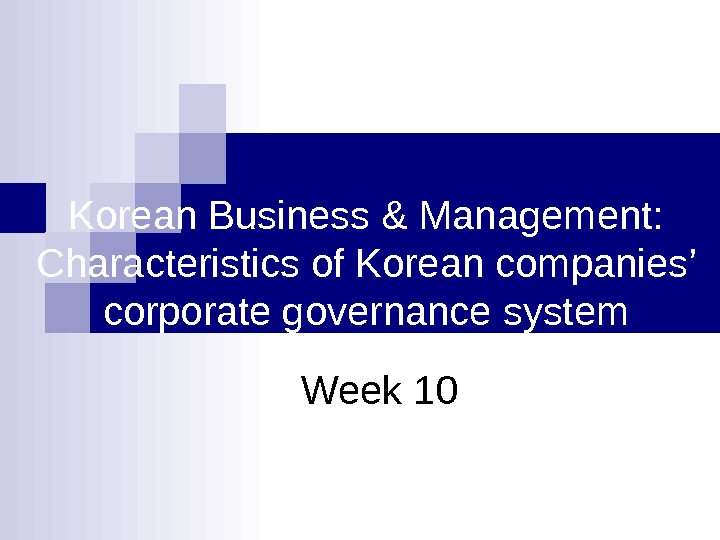
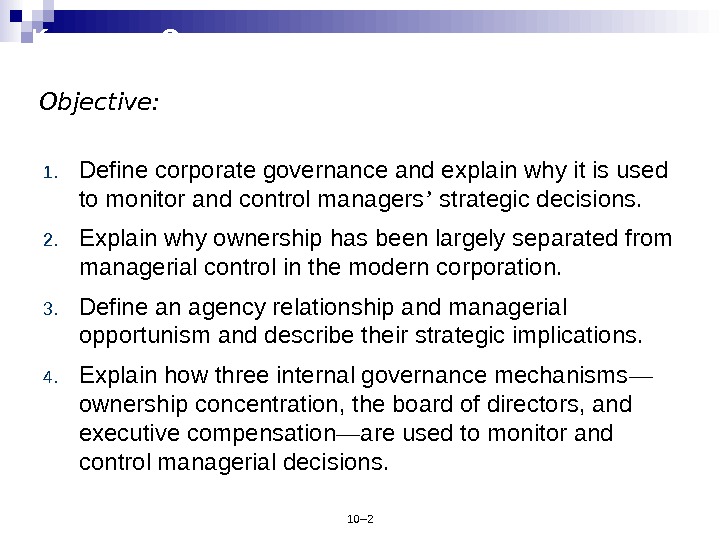

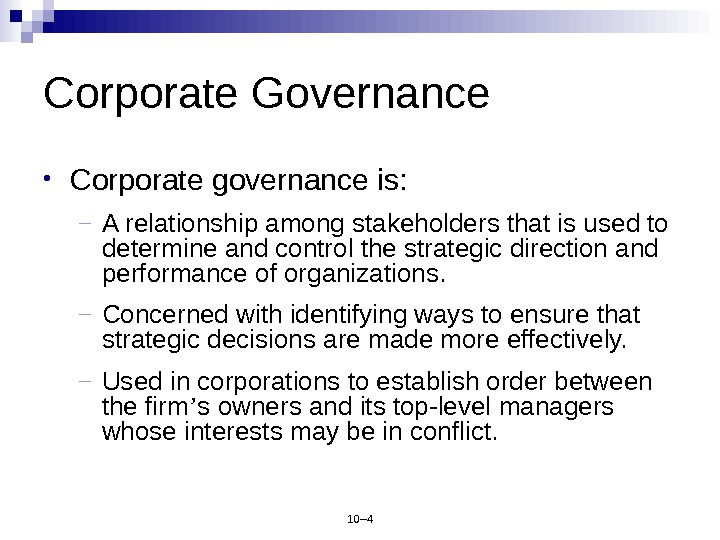
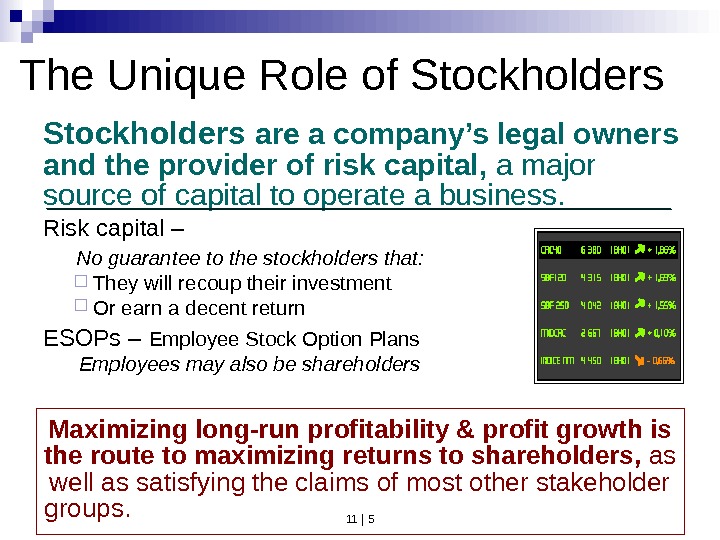
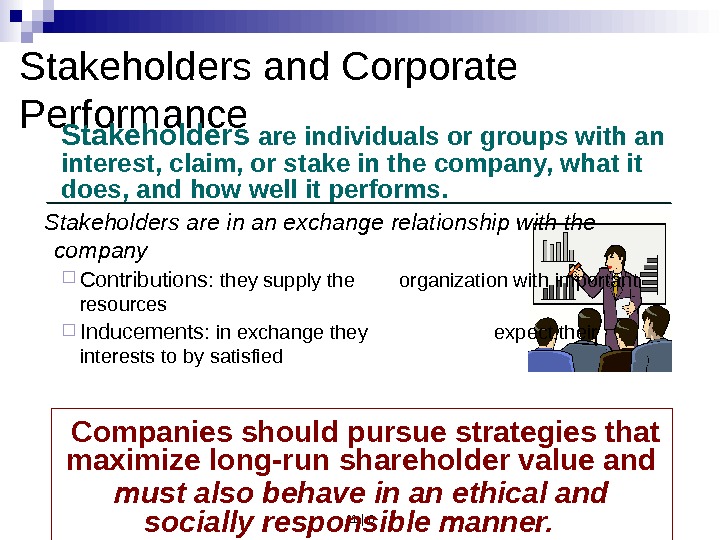
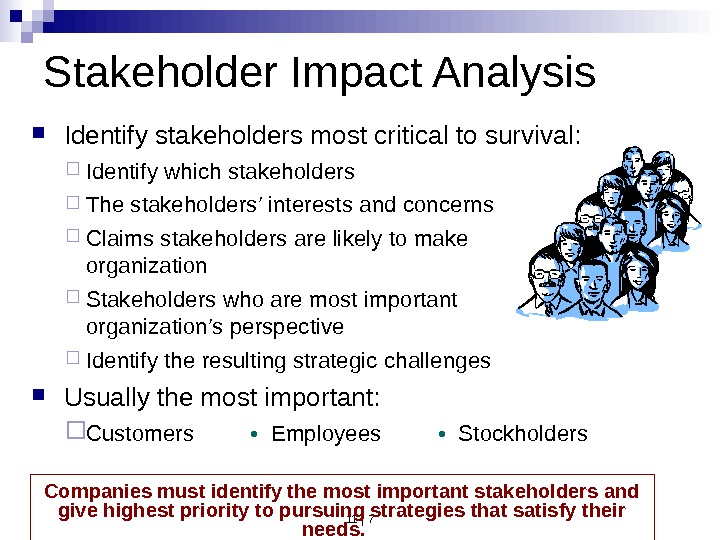
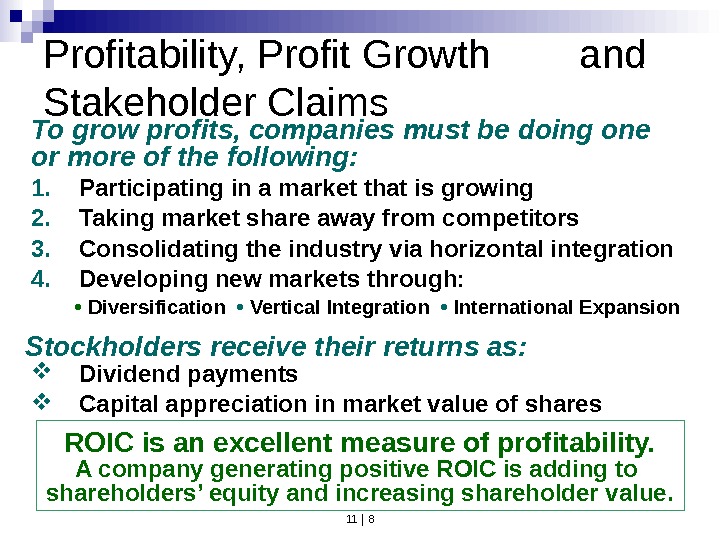
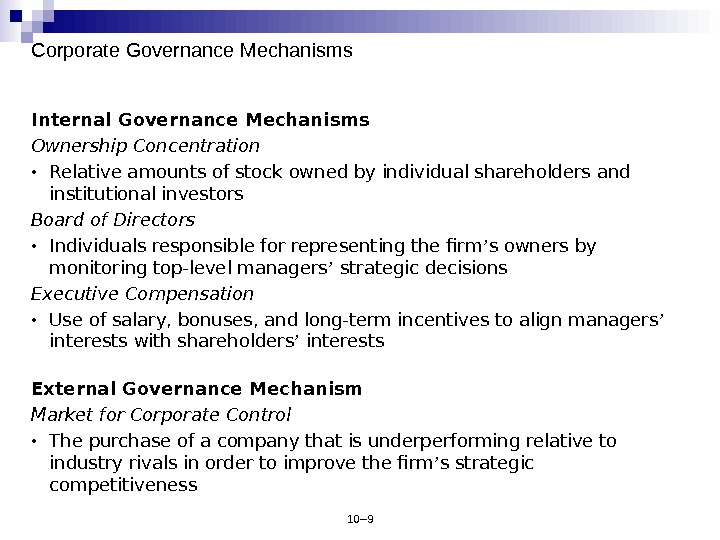

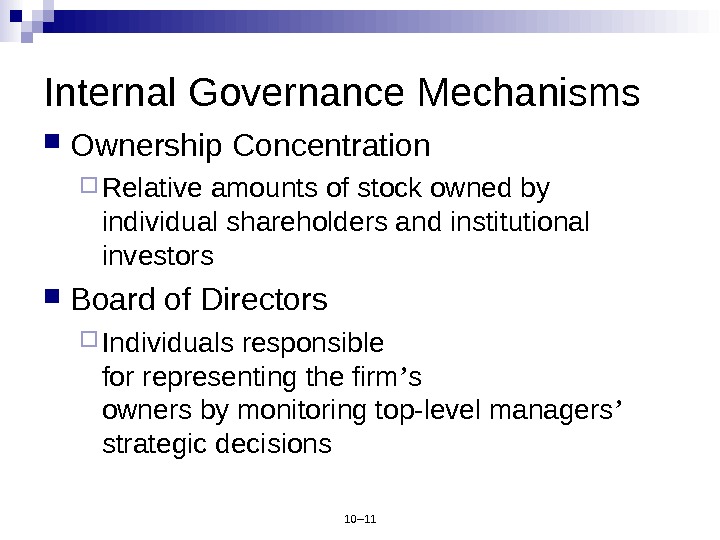
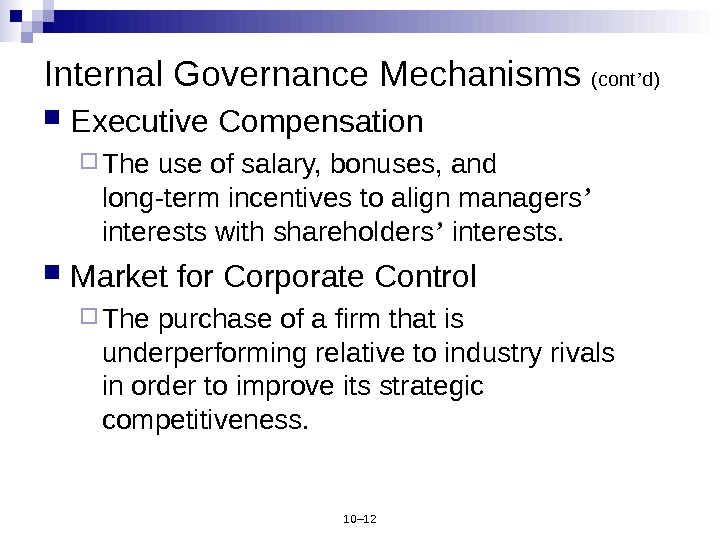
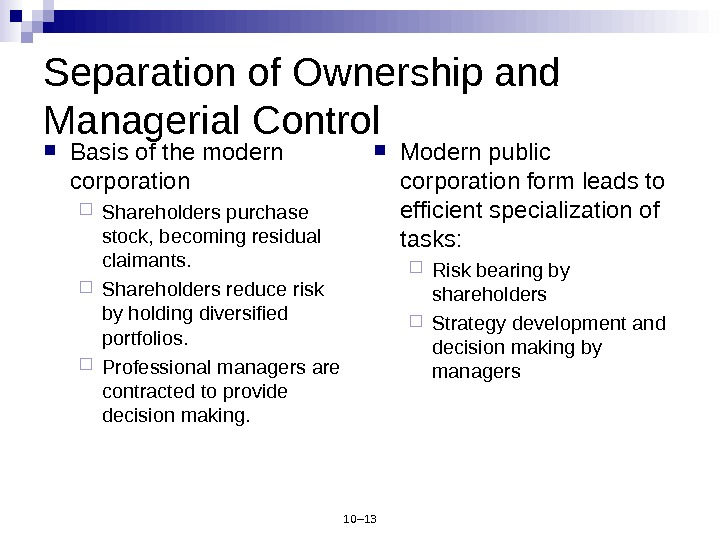


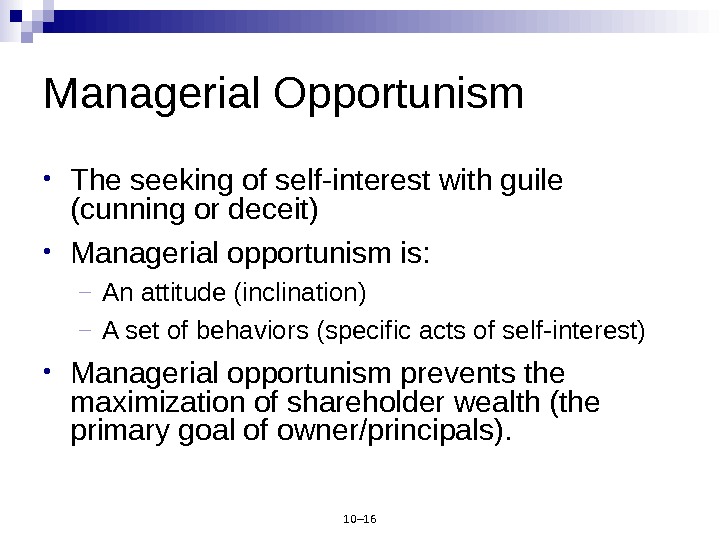
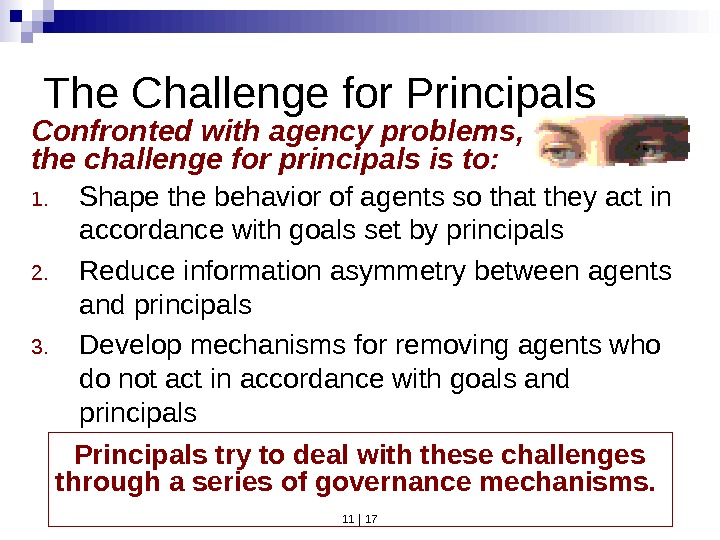
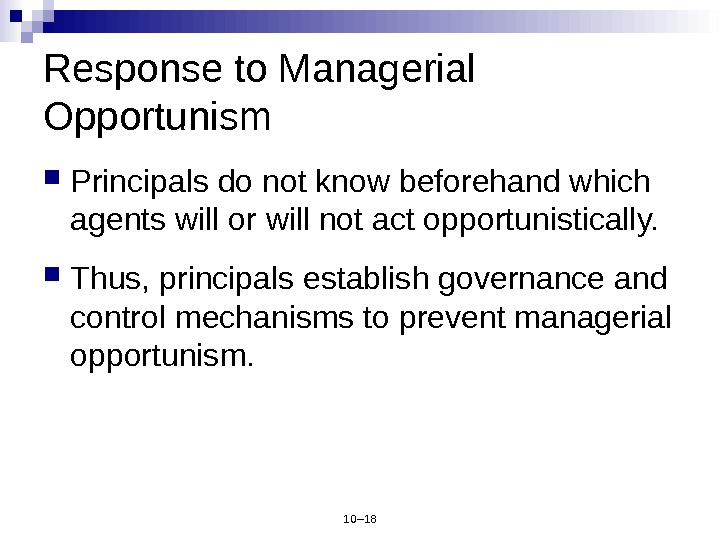

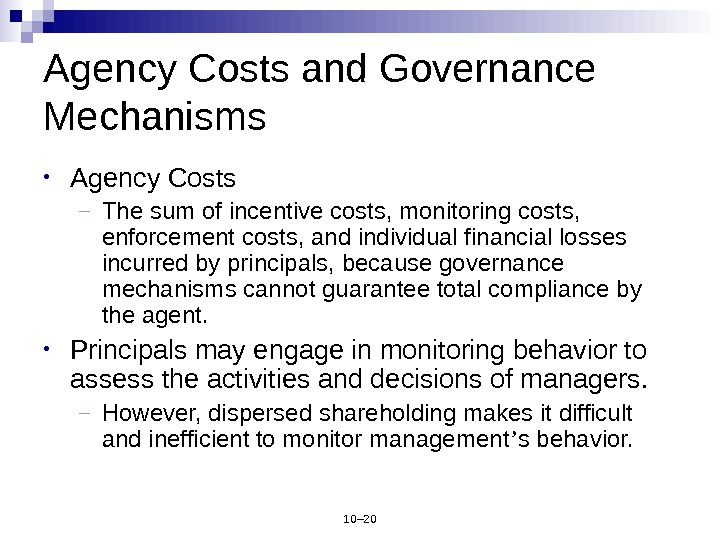



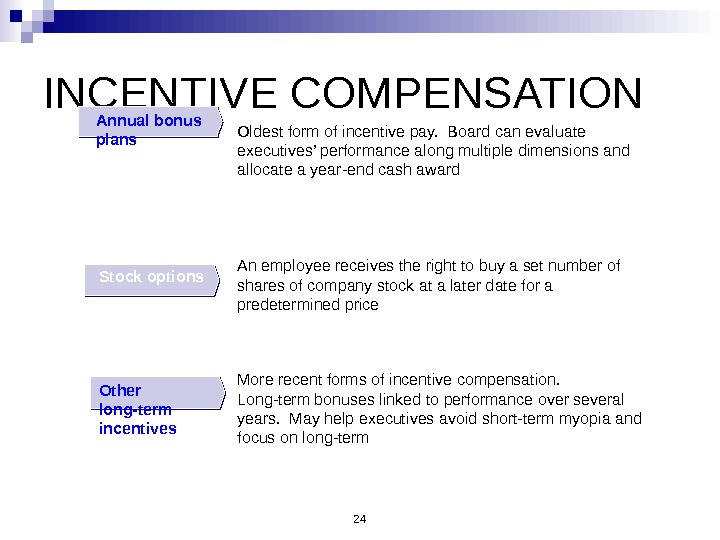
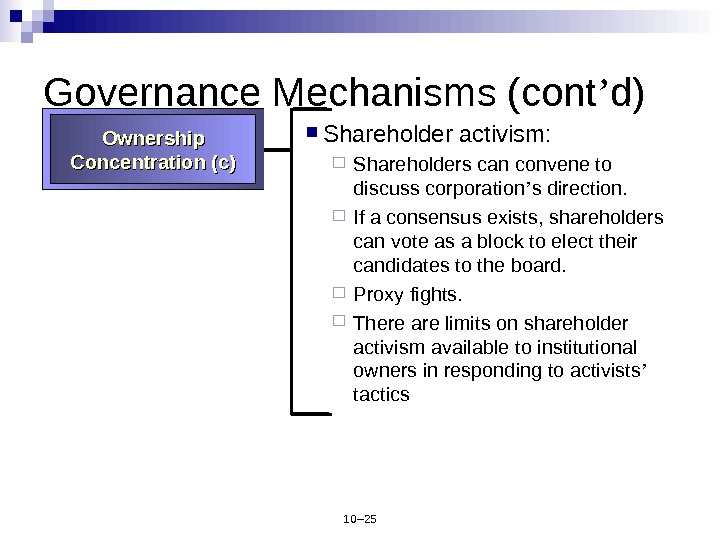
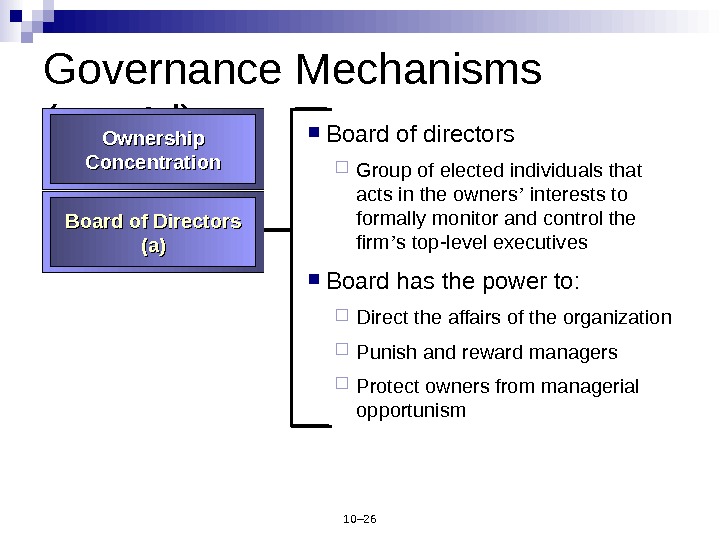
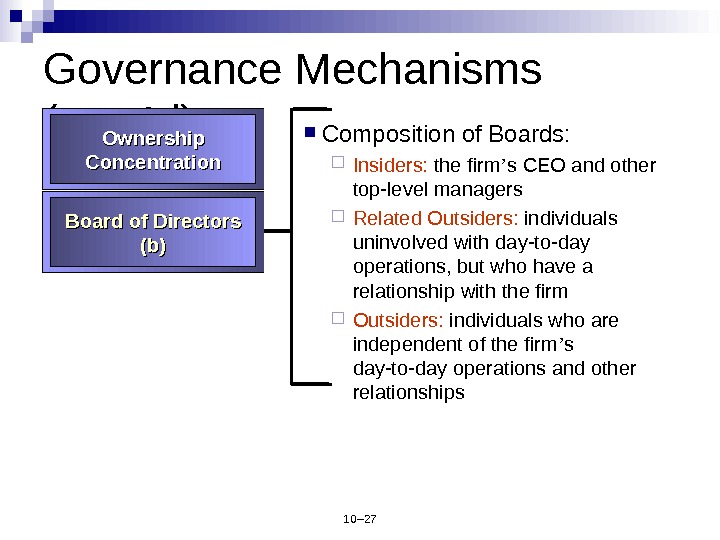
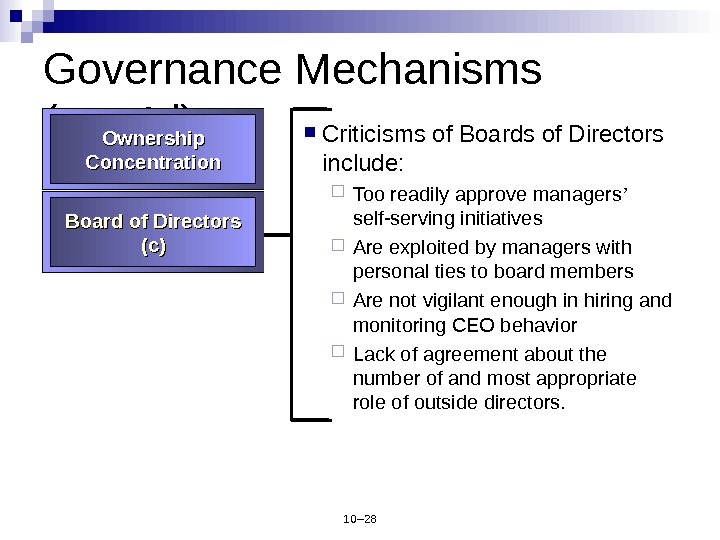
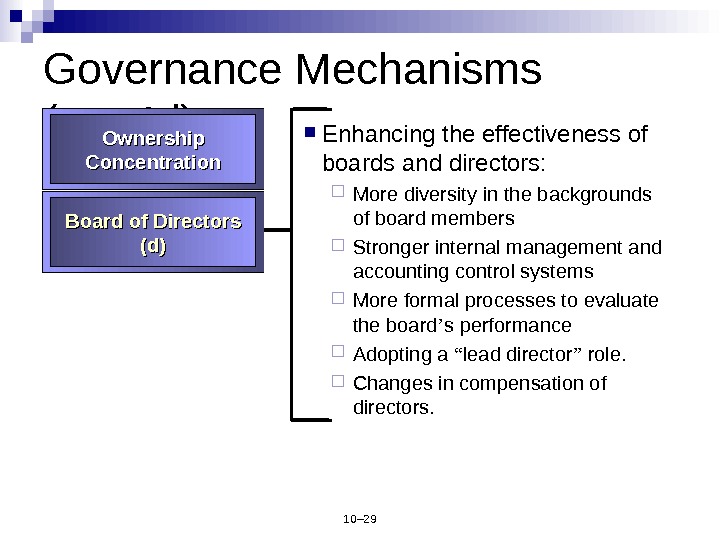

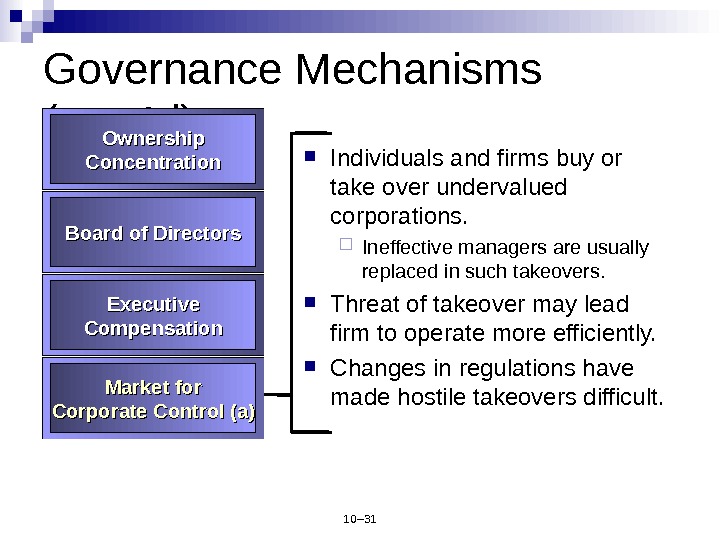
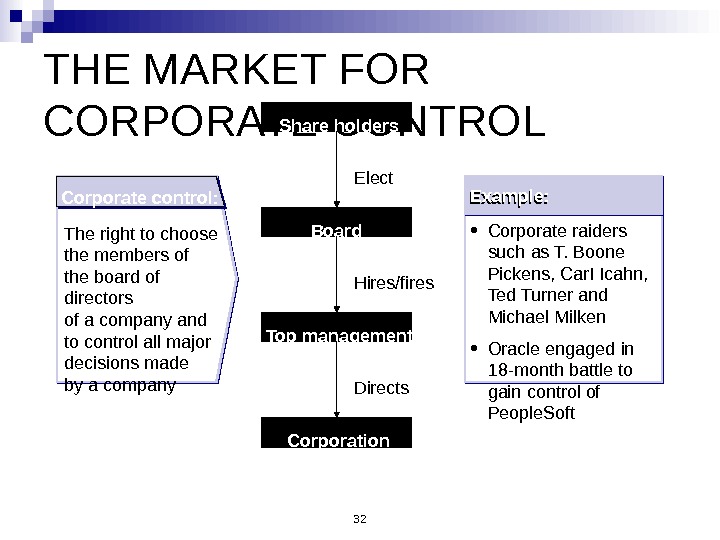
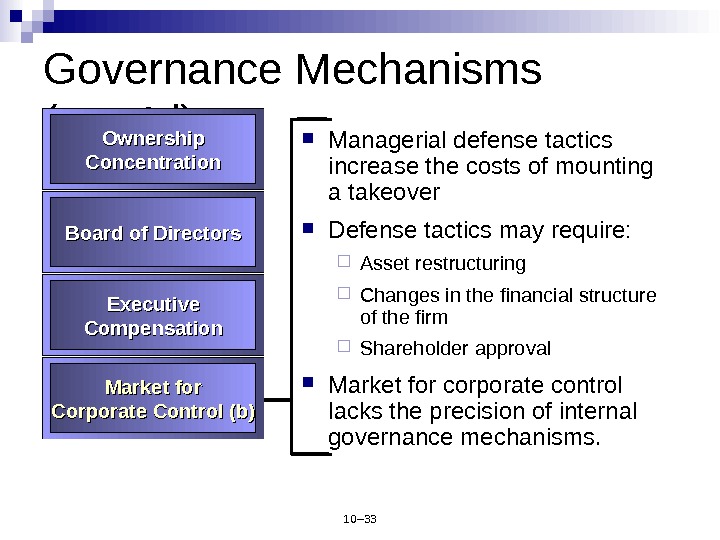
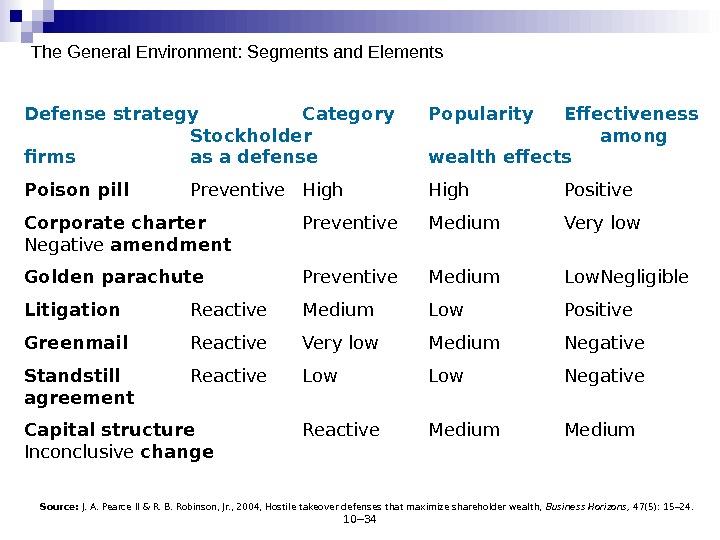

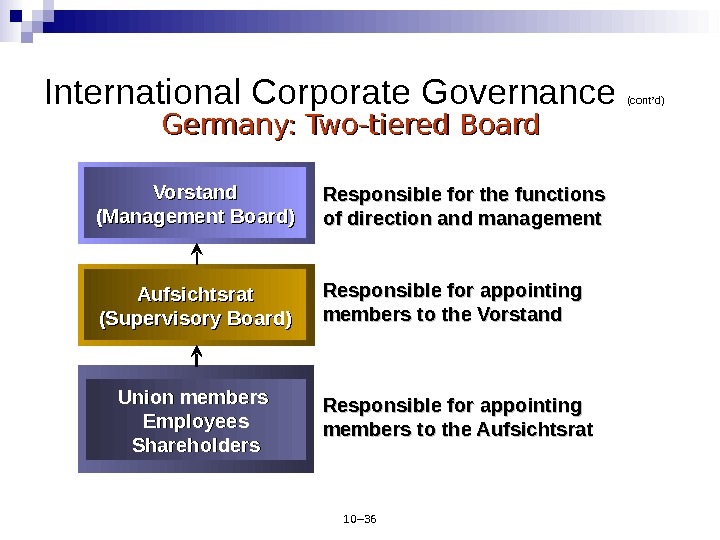

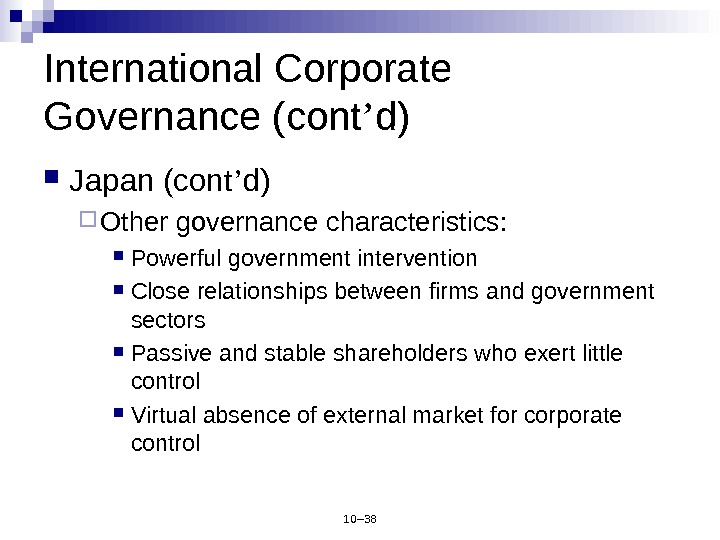
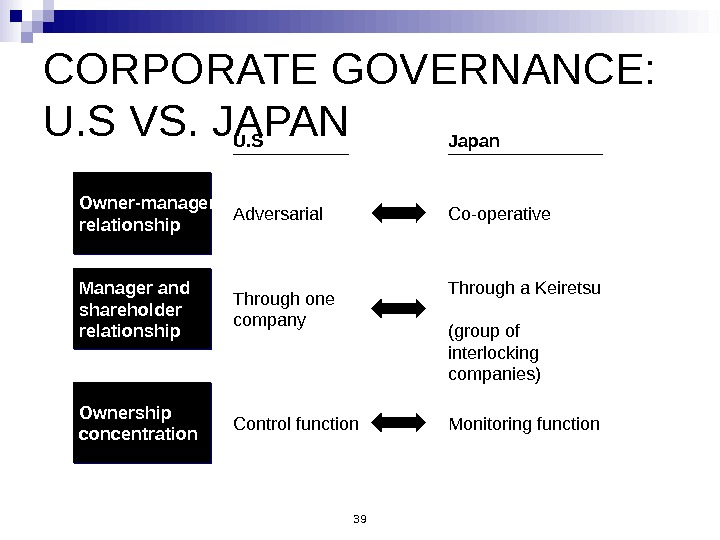
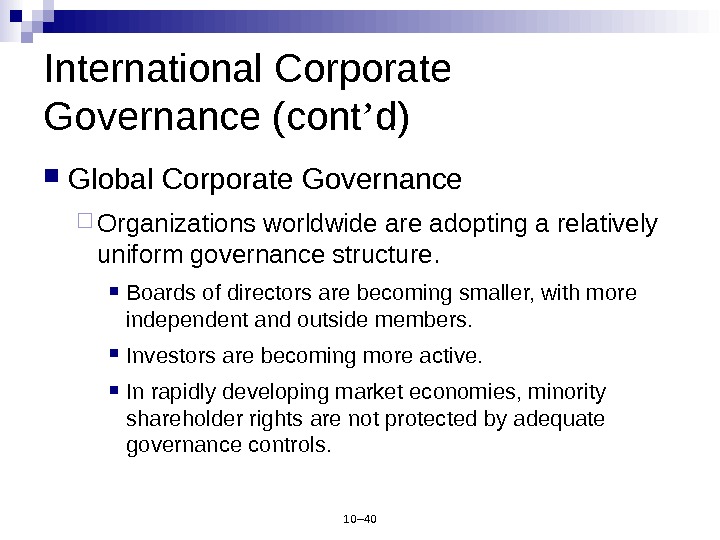
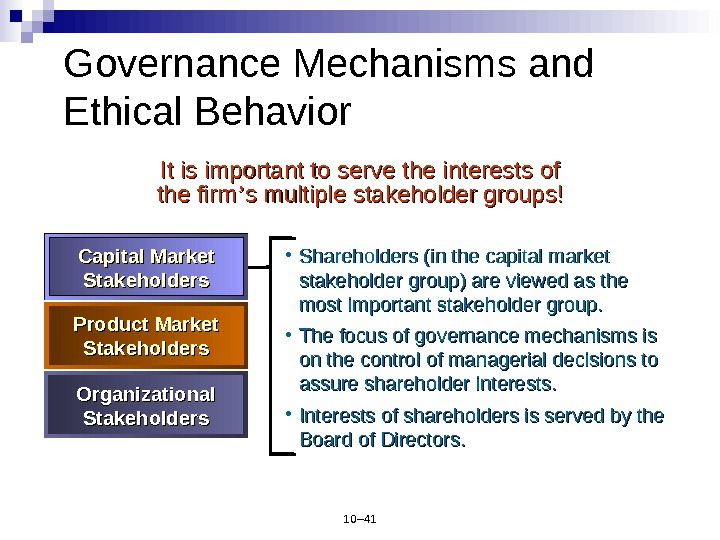
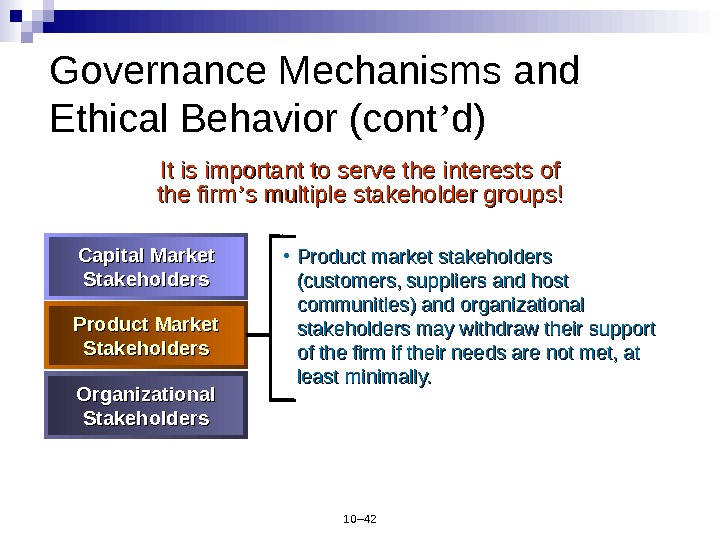
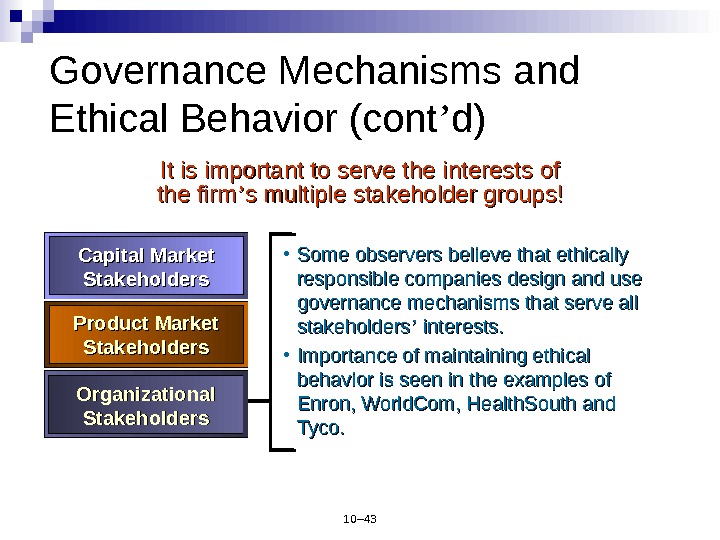
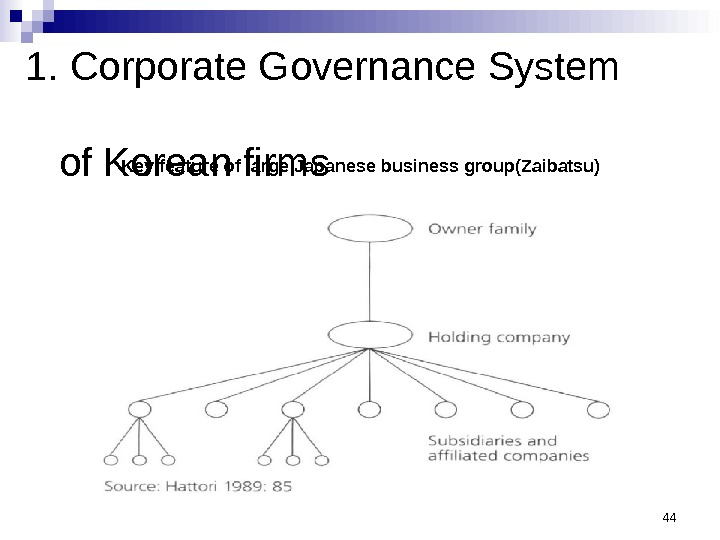
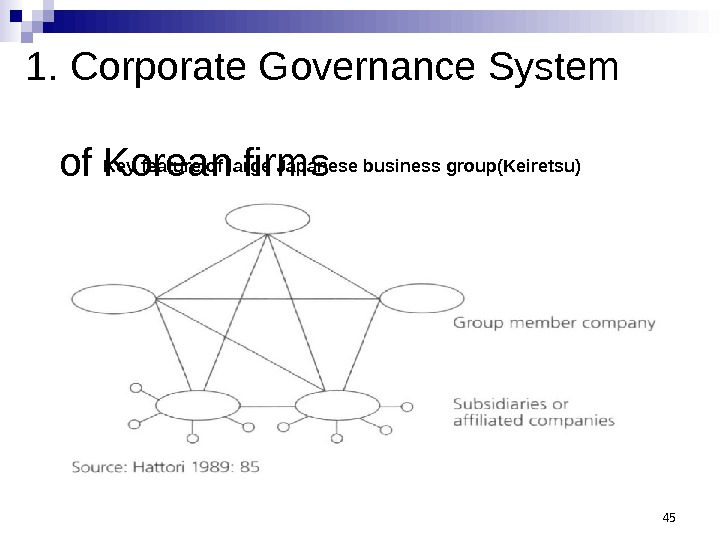
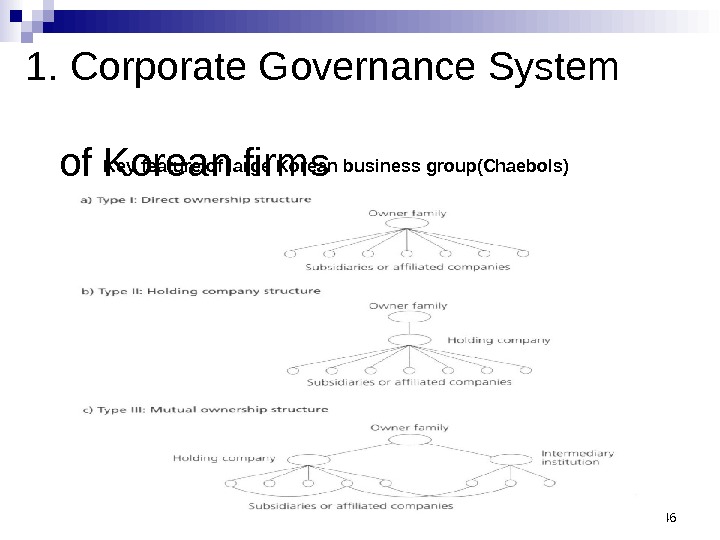

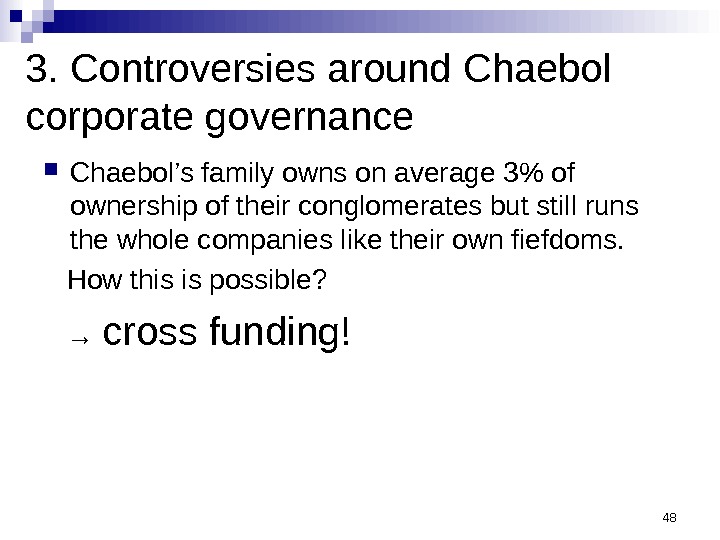


kbampm_week10_corporate_governance_system.ppt
- Размер: 1.2 Mегабайта
- Количество слайдов: 50
Описание презентации Korean Business & Management: Characteristics of Korean companies’ по слайдам
 Korean Business & Management: Characteristics of Korean companies’ corporate governance system Week
Korean Business & Management: Characteristics of Korean companies’ corporate governance system Week
 10– 2 K NOWLEDGE O BJECTIVES 1. Define corporate governance and explain why it is used to monitor and control managers ’ strategic decisions. 2. Explain why ownership has been largely separated from managerial control in the modern corporation. 3. Define an agency relationship and managerial opportunism and describe their strategic implications. 4. Explain how three internal governance mechanisms — ownership concentration, the board of directors, and executive compensation — are used to monitor and control managerial decisions. Objective:
10– 2 K NOWLEDGE O BJECTIVES 1. Define corporate governance and explain why it is used to monitor and control managers ’ strategic decisions. 2. Explain why ownership has been largely separated from managerial control in the modern corporation. 3. Define an agency relationship and managerial opportunism and describe their strategic implications. 4. Explain how three internal governance mechanisms — ownership concentration, the board of directors, and executive compensation — are used to monitor and control managerial decisions. Objective:
 10– 3 K NOWLEDGE O BJECTIVES (cont ’ d) 5. Discuss the types of compensation executives receive and their effects on strategic decisions. 6. Describe how the external corporate governance mechanism — the market for corporate control — acts as a restraint on top-level managers ’ strategic decisions. 7. Discuss the use of corporate governance in international settings, in particular in Germany and Japan. 8. Describe how corporate governance fosters ethical strategic decisions and the importance of such behaviors on the part of top-level executives. Objective (cont. ):
10– 3 K NOWLEDGE O BJECTIVES (cont ’ d) 5. Discuss the types of compensation executives receive and their effects on strategic decisions. 6. Describe how the external corporate governance mechanism — the market for corporate control — acts as a restraint on top-level managers ’ strategic decisions. 7. Discuss the use of corporate governance in international settings, in particular in Germany and Japan. 8. Describe how corporate governance fosters ethical strategic decisions and the importance of such behaviors on the part of top-level executives. Objective (cont. ):
 10– 4 Corporate Governance • Corporate governance is: – A relationship among stakeholders that is used to determine and control the strategic direction and performance of organizations. – Concerned with identifying ways to ensure that strategic decisions are made more effectively. – Used in corporations to establish order between the firm ’ s owners and its top-level managers whose interests may be in conflict.
10– 4 Corporate Governance • Corporate governance is: – A relationship among stakeholders that is used to determine and control the strategic direction and performance of organizations. – Concerned with identifying ways to ensure that strategic decisions are made more effectively. – Used in corporations to establish order between the firm ’ s owners and its top-level managers whose interests may be in conflict.
 11 | 5 Risk capital – No guarantee to the stockholders that: They will recoup their investment Or earn a decent return ESOPs – Employee Stock Option Plans Employees may also be shareholders. Stockholders are a company’s legal owners and the provider of risk capital, a major source of capital to operate a business. Maximizing long-run profitability & profit growth is the route to maximizing returns to shareholders, as well as satisfying the claims of most other stakeholder groups. The Unique Role of Stockholders
11 | 5 Risk capital – No guarantee to the stockholders that: They will recoup their investment Or earn a decent return ESOPs – Employee Stock Option Plans Employees may also be shareholders. Stockholders are a company’s legal owners and the provider of risk capital, a major source of capital to operate a business. Maximizing long-run profitability & profit growth is the route to maximizing returns to shareholders, as well as satisfying the claims of most other stakeholder groups. The Unique Role of Stockholders
 11 | 6 Stakeholders and Corporate Performance Stakeholders are in an exchange relationship with the company Contributions: they supply the organization with important resources Inducements: in exchange they expect their interests to by satisfied. Stakeholders are individuals or groups with an interest, claim, or stake in the company, what it does, and how well it performs. Companies should pursue strategies that maximize long-run shareholder value and must also behave in an ethical and socially responsible manner.
11 | 6 Stakeholders and Corporate Performance Stakeholders are in an exchange relationship with the company Contributions: they supply the organization with important resources Inducements: in exchange they expect their interests to by satisfied. Stakeholders are individuals or groups with an interest, claim, or stake in the company, what it does, and how well it performs. Companies should pursue strategies that maximize long-run shareholder value and must also behave in an ethical and socially responsible manner.
 11 | 7 Identify stakeholders most critical to survival: Identify which stakeholders The stakeholders’ interests and concerns Claims stakeholders are likely to make on the organization Stakeholders who are most important to the organization’s perspective Identify the resulting strategic challenges Usually the most important: Customers • Employees • Stockholders. Stakeholder Impact Analysis Companies must identify the most important stakeholders and give highest priority to pursuing strategies that satisfy their needs.
11 | 7 Identify stakeholders most critical to survival: Identify which stakeholders The stakeholders’ interests and concerns Claims stakeholders are likely to make on the organization Stakeholders who are most important to the organization’s perspective Identify the resulting strategic challenges Usually the most important: Customers • Employees • Stockholders. Stakeholder Impact Analysis Companies must identify the most important stakeholders and give highest priority to pursuing strategies that satisfy their needs.
 11 | 8 Profitability, Profit Growth and Stakeholder Claims 1. Participating in a market that is growing 2. Taking market share away from competitors 3. Consolidating the industry via horizontal integration 4. Developing new markets through: • Diversification • Vertical Integration • International Expansion. To grow profits, companies must be doing one or more of the following: Stockholders receive their returns as: Dividend payments Capital appreciation in market value of shares ROIC is an excellent measure of profitability. A company generating positive ROIC is adding to shareholders’ equity and increasing shareholder value.
11 | 8 Profitability, Profit Growth and Stakeholder Claims 1. Participating in a market that is growing 2. Taking market share away from competitors 3. Consolidating the industry via horizontal integration 4. Developing new markets through: • Diversification • Vertical Integration • International Expansion. To grow profits, companies must be doing one or more of the following: Stockholders receive their returns as: Dividend payments Capital appreciation in market value of shares ROIC is an excellent measure of profitability. A company generating positive ROIC is adding to shareholders’ equity and increasing shareholder value.
 10– 9 Corporate Governance Mechanisms Internal Governance Mechanisms Ownership Concentration • Relative amounts of stock owned by individual shareholders and institutional investors Board of Directors • Individuals responsible for representing the firm ’ s owners by monitoring top-level managers ’ strategic decisions Executive Compensation • Use of salary, bonuses, and long-term incentives to align managers ’ interests with shareholders ’ interests External Governance Mechanism Market for Corporate Control • The purchase of a company that is underperforming relative to industry rivals in order to improve the firm ’ s strategic competitiveness
10– 9 Corporate Governance Mechanisms Internal Governance Mechanisms Ownership Concentration • Relative amounts of stock owned by individual shareholders and institutional investors Board of Directors • Individuals responsible for representing the firm ’ s owners by monitoring top-level managers ’ strategic decisions Executive Compensation • Use of salary, bonuses, and long-term incentives to align managers ’ interests with shareholders ’ interests External Governance Mechanism Market for Corporate Control • The purchase of a company that is underperforming relative to industry rivals in order to improve the firm ’ s strategic competitiveness
 11 | 10 Governance Mechanisms Governance mechanisms serve to limit the agency problem by aligning incentives between agents and principals and by monitoring and controlling agents. The Board of Directors Elected by stockholders Legally accountable Monitors corporate strategy decisions Authority to hire, fire, and compensate Ensures accuracy of audited financial statements Inside directors Outside directors Stock-Based Compensation • Pay-for-performance • Stock options: The right to buy company shares at a predetermined price at some point in the future Financial Statements • Auditors • SEC • GAAP The Takeover Constraint • Limits strategies that ignore shareholder interests • Corporate raiders
11 | 10 Governance Mechanisms Governance mechanisms serve to limit the agency problem by aligning incentives between agents and principals and by monitoring and controlling agents. The Board of Directors Elected by stockholders Legally accountable Monitors corporate strategy decisions Authority to hire, fire, and compensate Ensures accuracy of audited financial statements Inside directors Outside directors Stock-Based Compensation • Pay-for-performance • Stock options: The right to buy company shares at a predetermined price at some point in the future Financial Statements • Auditors • SEC • GAAP The Takeover Constraint • Limits strategies that ignore shareholder interests • Corporate raiders
 10– 11 Internal Governance Mechanisms Ownership Concentration Relative amounts of stock owned by individual shareholders and institutional investors Board of Directors Individuals responsible for representing the firm ’ s owners by monitoring top-level managers ’ strategic decisions
10– 11 Internal Governance Mechanisms Ownership Concentration Relative amounts of stock owned by individual shareholders and institutional investors Board of Directors Individuals responsible for representing the firm ’ s owners by monitoring top-level managers ’ strategic decisions
 10– 12 Internal Governance Mechanisms (cont ’ d) Executive Compensation The use of salary, bonuses, and long-term incentives to align managers ’ interests with shareholders ’ interests. Market for Corporate Control The purchase of a firm that is underperforming relative to industry rivals in order to improve its strategic competitiveness.
10– 12 Internal Governance Mechanisms (cont ’ d) Executive Compensation The use of salary, bonuses, and long-term incentives to align managers ’ interests with shareholders ’ interests. Market for Corporate Control The purchase of a firm that is underperforming relative to industry rivals in order to improve its strategic competitiveness.
 10– 13 Separation of Ownership and Managerial Control Basis of the modern corporation Shareholders purchase stock, becoming residual claimants. Shareholders reduce risk by holding diversified portfolios. Professional managers are contracted to provide decision making. Modern public corporation form leads to efficient specialization of tasks: Risk bearing by shareholders Strategy development and decision making by managers
10– 13 Separation of Ownership and Managerial Control Basis of the modern corporation Shareholders purchase stock, becoming residual claimants. Shareholders reduce risk by holding diversified portfolios. Professional managers are contracted to provide decision making. Modern public corporation form leads to efficient specialization of tasks: Risk bearing by shareholders Strategy development and decision making by managers
 10– 14 An Agency Relationship
10– 14 An Agency Relationship
 10– 15 Agency Relationship Problems Principal and agent have divergent interests and goals. Shareholders lack direct control of large, publicly traded corporations. Agent makes decisions that result in the pursuit of goals that conflict with those of the principal. It is difficult or expensive for the principal to verify that the agent has behaved appropriately. Agent falls prey to managerial opportunism.
10– 15 Agency Relationship Problems Principal and agent have divergent interests and goals. Shareholders lack direct control of large, publicly traded corporations. Agent makes decisions that result in the pursuit of goals that conflict with those of the principal. It is difficult or expensive for the principal to verify that the agent has behaved appropriately. Agent falls prey to managerial opportunism.
 10– 16 Managerial Opportunism • The seeking of self-interest with guile (cunning or deceit) • Managerial opportunism is: – An attitude (inclination) – A set of behaviors (specific acts of self-interest) • Managerial opportunism prevents the maximization of shareholder wealth (the primary goal of owner/principals).
10– 16 Managerial Opportunism • The seeking of self-interest with guile (cunning or deceit) • Managerial opportunism is: – An attitude (inclination) – A set of behaviors (specific acts of self-interest) • Managerial opportunism prevents the maximization of shareholder wealth (the primary goal of owner/principals).
 11 | 17 The Challenge for Principals 1. Shape the behavior of agents so that they act in accordance with goals set by principals 2. Reduce information asymmetry between agents and principals 3. Develop mechanisms for removing agents who do not act in accordance with goals and principals. Confronted with agency problems, the challenge for principals is to: Principals try to deal with these challenges through a series of governance mechanisms.
11 | 17 The Challenge for Principals 1. Shape the behavior of agents so that they act in accordance with goals set by principals 2. Reduce information asymmetry between agents and principals 3. Develop mechanisms for removing agents who do not act in accordance with goals and principals. Confronted with agency problems, the challenge for principals is to: Principals try to deal with these challenges through a series of governance mechanisms.
 10– 18 Response to Managerial Opportunism Principals do not know beforehand which agents will or will not act opportunistically. Thus, principals establish governance and control mechanisms to prevent managerial opportunism.
10– 18 Response to Managerial Opportunism Principals do not know beforehand which agents will or will not act opportunistically. Thus, principals establish governance and control mechanisms to prevent managerial opportunism.
 10– 19 Examples of the Agency Problem • The Problem of Product Diversification – Increased size, and the relationship of size to managerial compensation – Reduction of managerial employment risk • Use of Free Cash Flows – Managers prefer to invest these funds in additional product diversification (see above). – Shareholders prefer the funds as dividends so they control how the funds are invested.
10– 19 Examples of the Agency Problem • The Problem of Product Diversification – Increased size, and the relationship of size to managerial compensation – Reduction of managerial employment risk • Use of Free Cash Flows – Managers prefer to invest these funds in additional product diversification (see above). – Shareholders prefer the funds as dividends so they control how the funds are invested.
 10– 20 Agency Costs and Governance Mechanisms • Agency Costs – The sum of incentive costs, monitoring costs, enforcement costs, and individual financial losses incurred by principals, because governance mechanisms cannot guarantee total compliance by the agent. • Principals may engage in monitoring behavior to assess the activities and decisions of managers. – However, dispersed shareholding makes it difficult and inefficient to monitor management ’ s behavior.
10– 20 Agency Costs and Governance Mechanisms • Agency Costs – The sum of incentive costs, monitoring costs, enforcement costs, and individual financial losses incurred by principals, because governance mechanisms cannot guarantee total compliance by the agent. • Principals may engage in monitoring behavior to assess the activities and decisions of managers. – However, dispersed shareholding makes it difficult and inefficient to monitor management ’ s behavior.
 10– 21 Agency Costs and Governance Mechanisms (cont ’ d) Boards of Directors have a fiduciary duty to shareholders to monitor management. However, Boards of Directors are often accused of being lax in performing this function.
10– 21 Agency Costs and Governance Mechanisms (cont ’ d) Boards of Directors have a fiduciary duty to shareholders to monitor management. However, Boards of Directors are often accused of being lax in performing this function.
 10– 22 Governance Mechanisms • Large block shareholders have a strong incentive to monitor management closely: – Their large stakes make it worth their while to spend time, effort and expense to monitor closely. – They may also obtain Board seats which enhances their ability to monitor effectively. • Financial institutions are legally forbidden from directly holding board seats. Ownership Concentration (a)
10– 22 Governance Mechanisms • Large block shareholders have a strong incentive to monitor management closely: – Their large stakes make it worth their while to spend time, effort and expense to monitor closely. – They may also obtain Board seats which enhances their ability to monitor effectively. • Financial institutions are legally forbidden from directly holding board seats. Ownership Concentration (a)
 10– 23 Governance Mechanisms (cont ’ d) The increasing influence of institutional owners (stock mutual funds and pension funds) Have the size (proxy voting power) and incentive (demand for returns to funds) to discipline ineffective top-level managers. Can affect the firm ’ s choice of strategies. Ownership Concentration (b)
10– 23 Governance Mechanisms (cont ’ d) The increasing influence of institutional owners (stock mutual funds and pension funds) Have the size (proxy voting power) and incentive (demand for returns to funds) to discipline ineffective top-level managers. Can affect the firm ’ s choice of strategies. Ownership Concentration (b)
 24 INCENTIVE COMPENSATION Annual bonus plans Oldest form of incentive pay. Board can evaluate executives’ performance along multiple dimensions and allocate a year-end cash award Stock options An employee receives the right to buy a set number of shares of company stock at a later date for a predetermined price Other long-term incentives More recent forms of incentive compensation. Long-term bonuses linked to performance over several years. May help executives avoid short-term myopia and focus on long-term
24 INCENTIVE COMPENSATION Annual bonus plans Oldest form of incentive pay. Board can evaluate executives’ performance along multiple dimensions and allocate a year-end cash award Stock options An employee receives the right to buy a set number of shares of company stock at a later date for a predetermined price Other long-term incentives More recent forms of incentive compensation. Long-term bonuses linked to performance over several years. May help executives avoid short-term myopia and focus on long-term
 10– 25 Governance Mechanisms (cont ’ d) Shareholder activism: Shareholders can convene to discuss corporation ’ s direction. If a consensus exists, shareholders can vote as a block to elect their candidates to the board. Proxy fights. There are limits on shareholder activism available to institutional owners in responding to activists ’ tactics. Ownership Concentration (c)
10– 25 Governance Mechanisms (cont ’ d) Shareholder activism: Shareholders can convene to discuss corporation ’ s direction. If a consensus exists, shareholders can vote as a block to elect their candidates to the board. Proxy fights. There are limits on shareholder activism available to institutional owners in responding to activists ’ tactics. Ownership Concentration (c)
 10– 26 Governance Mechanisms (cont ’ d) Board of directors Group of elected individuals that acts in the owners ’ interests to formally monitor and control the firm ’ s top-level executives Board has the power to: Direct the affairs of the organization Punish and reward managers Protect owners from managerial opportunism. Ownership Concentration Board of Directors (a)(a)
10– 26 Governance Mechanisms (cont ’ d) Board of directors Group of elected individuals that acts in the owners ’ interests to formally monitor and control the firm ’ s top-level executives Board has the power to: Direct the affairs of the organization Punish and reward managers Protect owners from managerial opportunism. Ownership Concentration Board of Directors (a)(a)
 10– 27 Governance Mechanisms (cont ’ d) Composition of Boards: Insiders: the firm ’ s CEO and other top-level managers Related Outsiders: individuals uninvolved with day-to-day operations, but who have a relationship with the firm Outsiders: individuals who are independent of the firm ’ s day-to-day operations and other relationships. Ownership Concentration Board of Directors (b)(b)
10– 27 Governance Mechanisms (cont ’ d) Composition of Boards: Insiders: the firm ’ s CEO and other top-level managers Related Outsiders: individuals uninvolved with day-to-day operations, but who have a relationship with the firm Outsiders: individuals who are independent of the firm ’ s day-to-day operations and other relationships. Ownership Concentration Board of Directors (b)(b)
 10– 28 Governance Mechanisms (cont ’ d) Criticisms of Boards of Directors include: Too readily approve managers ’ self-serving initiatives Are exploited by managers with personal ties to board members Are not vigilant enough in hiring and monitoring CEO behavior Lack of agreement about the number of and most appropriate role of outside directors. Ownership Concentration Board of Directors (c)(c)
10– 28 Governance Mechanisms (cont ’ d) Criticisms of Boards of Directors include: Too readily approve managers ’ self-serving initiatives Are exploited by managers with personal ties to board members Are not vigilant enough in hiring and monitoring CEO behavior Lack of agreement about the number of and most appropriate role of outside directors. Ownership Concentration Board of Directors (c)(c)
 10– 29 Governance Mechanisms (cont ’ d) Enhancing the effectiveness of boards and directors: More diversity in the backgrounds of board members Stronger internal management and accounting control systems More formal processes to evaluate the board ’ s performance Adopting a “ lead director ” role. Changes in compensation of directors. Ownership Concentration Board of Directors (d)(d)
10– 29 Governance Mechanisms (cont ’ d) Enhancing the effectiveness of boards and directors: More diversity in the backgrounds of board members Stronger internal management and accounting control systems More formal processes to evaluate the board ’ s performance Adopting a “ lead director ” role. Changes in compensation of directors. Ownership Concentration Board of Directors (d)(d)
 10– 30 Governance Mechanisms (cont ’ d) Forms of compensation: Salaries, bonuses, long-term performance incentives, stock awards, stock options Factors complicating executive compensation: Strategic decisions by top-level managers are complex, non-routine and affect the firm over an extended period. Other variables affecting the firm ’ s performance over time. Ownership Concentration Executive Compensation Board of Directors
10– 30 Governance Mechanisms (cont ’ d) Forms of compensation: Salaries, bonuses, long-term performance incentives, stock awards, stock options Factors complicating executive compensation: Strategic decisions by top-level managers are complex, non-routine and affect the firm over an extended period. Other variables affecting the firm ’ s performance over time. Ownership Concentration Executive Compensation Board of Directors
 10– 31 Governance Mechanisms (cont ’ d) Individuals and firms buy or take over undervalued corporations. Ineffective managers are usually replaced in such takeovers. Threat of takeover may lead firm to operate more efficiently. Changes in regulations have made hostile takeovers difficult. Ownership Concentration Market for Corporate Control (a) Board of Directors Executive Compensation
10– 31 Governance Mechanisms (cont ’ d) Individuals and firms buy or take over undervalued corporations. Ineffective managers are usually replaced in such takeovers. Threat of takeover may lead firm to operate more efficiently. Changes in regulations have made hostile takeovers difficult. Ownership Concentration Market for Corporate Control (a) Board of Directors Executive Compensation
 32 THE MARKET FOR CORPORATE CONTROL Share holders Board Top management Corporation Directs. Hires/fires. Elect The right to choose the members of the board of directors of a company and to control all major decisions made by a company. Corporate control: Example: • Corporate raiders such as T. Boone Pickens, Car. I Icahn, Ted Turner and Michael Milken • Oracle engaged in 18 -month battle to gain control of People. Soft. Example:
32 THE MARKET FOR CORPORATE CONTROL Share holders Board Top management Corporation Directs. Hires/fires. Elect The right to choose the members of the board of directors of a company and to control all major decisions made by a company. Corporate control: Example: • Corporate raiders such as T. Boone Pickens, Car. I Icahn, Ted Turner and Michael Milken • Oracle engaged in 18 -month battle to gain control of People. Soft. Example:
 10– 33 Governance Mechanisms (cont ’ d) Managerial defense tactics increase the costs of mounting a takeover Defense tactics may require: Asset restructuring Changes in the financial structure of the firm Shareholder approval Market for corporate control lacks the precision of internal governance mechanisms. Ownership Concentration Executive Compensation Market for Corporate Control (b) Board of Directors
10– 33 Governance Mechanisms (cont ’ d) Managerial defense tactics increase the costs of mounting a takeover Defense tactics may require: Asset restructuring Changes in the financial structure of the firm Shareholder approval Market for corporate control lacks the precision of internal governance mechanisms. Ownership Concentration Executive Compensation Market for Corporate Control (b) Board of Directors
 10– 34 The General Environment: Segments and Elements Defense strategy Category Popularity Effectiveness Stockholder among firms as a defense wealth effects Poison pill Preventive High Positive Corporate charter Preventive Medium Very low Negative amendment Golden parachute Preventive Medium Low Negligible Litigation Reactive Medium Low Positive Greenmail Reactive Very low Medium Negative Standstill Reactive Low Negative agreement Capital structure Reactive Medium Inconclusive change Source: J. A. Pearce II & R. B. Robinson, Jr. , 2004, Hostile takeover defenses that maximize shareholder wealth, Business Horizons, 47(5): 15 – 24.
10– 34 The General Environment: Segments and Elements Defense strategy Category Popularity Effectiveness Stockholder among firms as a defense wealth effects Poison pill Preventive High Positive Corporate charter Preventive Medium Very low Negative amendment Golden parachute Preventive Medium Low Negligible Litigation Reactive Medium Low Positive Greenmail Reactive Very low Medium Negative Standstill Reactive Low Negative agreement Capital structure Reactive Medium Inconclusive change Source: J. A. Pearce II & R. B. Robinson, Jr. , 2004, Hostile takeover defenses that maximize shareholder wealth, Business Horizons, 47(5): 15 – 24.
 10– 35 International Corporate Governance Germany Owner and manager are often the same in private firms. Public firms often have a dominant shareholder, frequently a bank. Frequently there is less emphasis on shareholder value than in U. S. firms, although this may be changing.
10– 35 International Corporate Governance Germany Owner and manager are often the same in private firms. Public firms often have a dominant shareholder, frequently a bank. Frequently there is less emphasis on shareholder value than in U. S. firms, although this may be changing.
 10– 36 Responsible for the functions of direction and management Responsible for appointing members to the Vorstand Responsible for appointing members to the Aufsichtsrat. International Corporate Governance (cont ’ d) Vorstand (Management Board) Aufsichtsrat (Supervisory Board) Union members Employees Shareholders Germany: Two-tiered Board
10– 36 Responsible for the functions of direction and management Responsible for appointing members to the Vorstand Responsible for appointing members to the Aufsichtsrat. International Corporate Governance (cont ’ d) Vorstand (Management Board) Aufsichtsrat (Supervisory Board) Union members Employees Shareholders Germany: Two-tiered Board
 10– 37 International Corporate Governance (cont ’ d) • Japan – Important governance factors: • Obligation • “ Family ” • Consensus – Keiretsus: strongly interrelated groups of firms tied together by cross-shareholdings. – Banks (especially “ main bank ” ) are highly influential with firm ’ s managers
10– 37 International Corporate Governance (cont ’ d) • Japan – Important governance factors: • Obligation • “ Family ” • Consensus – Keiretsus: strongly interrelated groups of firms tied together by cross-shareholdings. – Banks (especially “ main bank ” ) are highly influential with firm ’ s managers
 10– 38 International Corporate Governance (cont ’ d) Japan (cont ’ d) Other governance characteristics: Powerful government intervention Close relationships between firms and government sectors Passive and stable shareholders who exert little control Virtual absence of external market for corporate control
10– 38 International Corporate Governance (cont ’ d) Japan (cont ’ d) Other governance characteristics: Powerful government intervention Close relationships between firms and government sectors Passive and stable shareholders who exert little control Virtual absence of external market for corporate control
 39 CORPORATE GOVERNANCE: U. S VS. JAPAN Owner-manager relationship Manager and shareholder relationship Ownership concentration U. S Adversarial Through one company Control function Japan Co-operative Through a Keiretsu (group of interlocking companies) Monitoring function
39 CORPORATE GOVERNANCE: U. S VS. JAPAN Owner-manager relationship Manager and shareholder relationship Ownership concentration U. S Adversarial Through one company Control function Japan Co-operative Through a Keiretsu (group of interlocking companies) Monitoring function
 10– 40 International Corporate Governance (cont ’ d) Global Corporate Governance Organizations worldwide are adopting a relatively uniform governance structure. Boards of directors are becoming smaller, with more independent and outside members. Investors are becoming more active. In rapidly developing market economies, minority shareholder rights are not protected by adequate governance controls.
10– 40 International Corporate Governance (cont ’ d) Global Corporate Governance Organizations worldwide are adopting a relatively uniform governance structure. Boards of directors are becoming smaller, with more independent and outside members. Investors are becoming more active. In rapidly developing market economies, minority shareholder rights are not protected by adequate governance controls.
 10– 41 Organizational Stakeholders. Product Market Stakeholders. Governance Mechanisms and Ethical Behavior It is important to serve the interests of the firm ’’ s multiple stakeholder groups! • Shareholders (in the capital market stakeholder group) are viewed as the most important stakeholder group. • The focus of governance mechanisms is on the control of managerial decisions to assure shareholder interests. • Interests of shareholders is served by the Board of Directors. Capital Market Stakeholders
10– 41 Organizational Stakeholders. Product Market Stakeholders. Governance Mechanisms and Ethical Behavior It is important to serve the interests of the firm ’’ s multiple stakeholder groups! • Shareholders (in the capital market stakeholder group) are viewed as the most important stakeholder group. • The focus of governance mechanisms is on the control of managerial decisions to assure shareholder interests. • Interests of shareholders is served by the Board of Directors. Capital Market Stakeholders
 10– 42 Organizational Stakeholders. Product Market Stakeholders. Capital Market Stakeholders. Governance Mechanisms and Ethical Behavior (cont ’ d) • Product market stakeholders (customers, suppliers and host communities) and organizational stakeholders may withdraw their support of the firm if their needs are not met, at least minimally. It is important to serve the interests of the firm ’’ s multiple stakeholder groups!
10– 42 Organizational Stakeholders. Product Market Stakeholders. Capital Market Stakeholders. Governance Mechanisms and Ethical Behavior (cont ’ d) • Product market stakeholders (customers, suppliers and host communities) and organizational stakeholders may withdraw their support of the firm if their needs are not met, at least minimally. It is important to serve the interests of the firm ’’ s multiple stakeholder groups!
 10– 43 Product Market Stakeholders Organizational Stakeholders. Capital Market Stakeholders. Governance Mechanisms and Ethical Behavior (cont ’ d) It is important to serve the interests of the firm ’’ s multiple stakeholder groups! • Some observers believe that ethically responsible companies design and use governance mechanisms that serve all stakeholders ’’ interests. • Importance of maintaining ethical behavior is seen in the examples of Enron, World. Com, Health. South and Tyco.
10– 43 Product Market Stakeholders Organizational Stakeholders. Capital Market Stakeholders. Governance Mechanisms and Ethical Behavior (cont ’ d) It is important to serve the interests of the firm ’’ s multiple stakeholder groups! • Some observers believe that ethically responsible companies design and use governance mechanisms that serve all stakeholders ’’ interests. • Importance of maintaining ethical behavior is seen in the examples of Enron, World. Com, Health. South and Tyco.
 1. Corporate Governance System of Korean firms 44 Key feature of large Japanese business group(Zaibatsu)
1. Corporate Governance System of Korean firms 44 Key feature of large Japanese business group(Zaibatsu)
 1. Corporate Governance System of Korean firms 45 Key feature of large Japanese business group(Keiretsu)
1. Corporate Governance System of Korean firms 45 Key feature of large Japanese business group(Keiretsu)
 1. Corporate Governance System of Korean firms 46 Key feature of large Korean business group(Chaebols)
1. Corporate Governance System of Korean firms 46 Key feature of large Korean business group(Chaebols)
 472. Corporate governance issues related to Korean Chaebols What has made Chaebol’s ownership structure survive for long period of time? Is Chaebol’s ownership structure truly inconsistent with goal of modern firm and shareholder profit maximization?
472. Corporate governance issues related to Korean Chaebols What has made Chaebol’s ownership structure survive for long period of time? Is Chaebol’s ownership structure truly inconsistent with goal of modern firm and shareholder profit maximization?
 483. Controversies around Chaebol corporate governance Chaebol’s family owns on average 3% of ownership of their conglomerates but still runs the whole companies like their own fiefdoms. How this is possible? → cross funding!
483. Controversies around Chaebol corporate governance Chaebol’s family owns on average 3% of ownership of their conglomerates but still runs the whole companies like their own fiefdoms. How this is possible? → cross funding!
 493. Controversies around Chaebol corporate governance (cont. ) Government attitude toward Chaebol recently dramatically changed after the financial crisis →pushing restructuring toward holding company structure However, still, lack of monitoring by financial institution and institutional investors is key characteristics of Korean Chaebol’s governance system
493. Controversies around Chaebol corporate governance (cont. ) Government attitude toward Chaebol recently dramatically changed after the financial crisis →pushing restructuring toward holding company structure However, still, lack of monitoring by financial institution and institutional investors is key characteristics of Korean Chaebol’s governance system
 503. Controversies around Chaebol corporate governance (cont. ) Whether Chaebol’s governance structure should be thrown away is subject to empirical evidence. Likewise, the question “should Chaebol firms be run by professional managers? ” is also matter of empirical evidence More urgent need is to have proper and effective monitoring systems to Korean Chaebols
503. Controversies around Chaebol corporate governance (cont. ) Whether Chaebol’s governance structure should be thrown away is subject to empirical evidence. Likewise, the question “should Chaebol firms be run by professional managers? ” is also matter of empirical evidence More urgent need is to have proper and effective monitoring systems to Korean Chaebols

